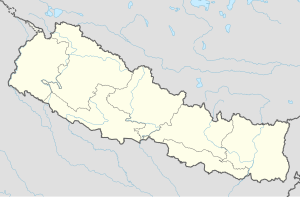
Back Keemathnka CEB किमाथान्का MAI Keemathnka Malay किमाथान्का Nepali कीमाथंका NEW Keemathanka Polish
Kimathanka
किमाथांका | |
|---|---|
Village (ward) | |
Map of the village development committees in Sankhuwasabha District | |
| Coordinates: 27°51′25″N 87°25′05″E / 27.8569°N 87.4181°E | |
| Country | |
| Province | Province No. 1 |
| District | Sankhuwasabha |
| Rural Municipality | Bhotkhola |
| Part of (ward) | Ward no. 1 |
| Area | |
• Total | 13.37 km2 (5.16 sq mi) |
| Population (2011) | |
• Total | 368 |
| • Density | 28/km2 (71/sq mi) |
| Time zone | UTC+5:45 (Nepal Time) |
Kimathanka is a village (previously, a village development committee) in Bhotkhola rural municipality of Sankhuwasabha District of Koshi Province, Nepal and serves as the Nepalese counterpart of the Nepal-China (Tibet autonomous region) border at Zhentang (Chentang). At the time of the 1991 census, it had a population of 303 people living in 50 individual households.[1]
Being among the most remote Himalayan villages of Nepal, Kimathanka is also the end point of the in-progress 362 kilometers long Biratnagar-Khandbari-Kimathanka road called Koshi Highway, which plans to connect the village with the provincial headquarter of Biratnagar and subsequently, with the Indian border town of Jogbani.[2][3] The Arun River runs through the valley below the village. In 2019, road embankment construction on the Chinese side led to fear of potential downstream flooding in Kimathanka.[4] In November 2020, Prime Minister of Nepal KP Sharma Oli visited Kimathanka inspecting the progress of Koshi Highway and other infrastructure projects in the area.[5][6]
- ^ "Nepal Census 2001". Nepal's Village Development Committees. Digital Himalaya. Archived from the original on 12 October 2008. Retrieved 19 November 2008.
- ^ Rana, Pratik. "Nepal Army entrusted to build 14km road section of Khadbari-Kimathanka Highway linking China". My Republica. Retrieved 2020-01-22.
- ^ "Road to connect China and India in Eastern region nears completion". kathmandupost.com. Retrieved 2020-01-22.
- ^ Giri, Anil; Shakya, Dipendra (13 January 2019). "Chinese construction along the Nepal-Tibet border puts strategic land at risk". The Kathmandu Post. Retrieved 2 September 2019.
- ^ "Koshi highway connecting Nepal, China and India soon: PM Oli". South Asian Monitor. November 12, 2020. Retrieved 22 November 2020.
Prime Minister KP Sharma Oli carried out an onsite visit of Kimathanka border point and North-South highway on Wednesday. On the occasion, he expressed his confidence that India and China would be connected with each other soon.
- ^ "PM Oli to visit Kimathanka on Wednesday". Khabarhub. November 10, 2020. Retrieved 22 November 2020.
Prime Minister's Press Adviser Surya Thapa said that Prime Minister Oli is visiting Kimathanka to inspect various projects including the Koshi Corridor.



